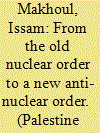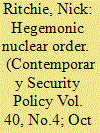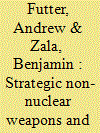|
|
|
Sort Order |
|
|
|
Items / Page
|
|
|
|
|
|
|
| Srl | Item |
| 1 |
ID:
077683


|
|
|
|
|
| Publication |
2007.
|
| Summary/Abstract |
Applying the method of enlightenment correctly to the area of nuclear non-proliferation would require a major effort to critically evaluate ideologies. Liberal arms control-despite its many successes and merits-has devised over the years a whole set of ideological tenets and attitudes. Some of them have been transformed into beliefs that could be termed myths. The most prominent ideological myth of the liberal arms control school is the notion that the Nuclear Non-proliferation Treaty of 1968 (NPT) was in essence a disarmament agreement, not a non-proliferation treaty. To depict the negotiations as a premeditated effort of enlightenment, where the governments of this world came together to solemnly decide that some of them would be allowed to have some nuclear weapons for an interim period while the others would renounce their possession immediately, is pure. It would be equally wrong to qualify the 'grand bargain' as one between the nuclear haves and the nuclear have-nots. Another myth of the liberal arms control school is the notion that-in order to gain support for the NPT-the superpowers had altered their nuclear weapons strategy in the 1960s. Again, this contention is not borne out by the development of nuclear strategies and doctrines. The third myth is the contention that there was an abrupt shift in US non-proliferation policy as George W. Bush came into power. The major changes in US non-proliferation policy had already started during the Clinton administration and some of them can be traced back to the tenure of President George W. H. Bush senior. They all reflected the changed international environment and represented necessary adjustments of the non-proliferation strategy. The Clinton administration left some of the traditional paths of arms control and rightly undertook some changes that were necessary because traditional instruments of arms control were no longer adequate. The Bush administration continued that policy, but in a more radical way.
|
|
|
|
|
|
|
|
|
|
|
|
|
|
|
|
| 2 |
ID:
094126


|
|
|
| 3 |
ID:
166070


|
|
|
|
|
| Summary/Abstract |
Foreign policy pundits have bemoaned the unraveling of the post-World War II international order in recent years, describing threats to the multilateralism and liberalism enshrined in postwar institutions. An often overlooked component of that structure is the global nuclear order, which, like other parts of the postwar system, was created for magnanimous and selfish aims: reducing the dangers of nuclear weapons for all and serving the interests of the world’s most powerful states.
|
|
|
|
|
|
|
|
|
|
|
|
|
|
|
|
| 4 |
ID:
168437


|
|
|
|
|
| Summary/Abstract |
The notion of a “global nuclear order” has entered the lexicon of nuclear politics. The 2017 Treaty on the Prohibition of Nuclear Weapons has prompted further questions about how we understand it. Yet missing from analysis of nuclear order and the “Ban Treaty” is a critical analysis of the power relations that constitute that order. This article develops a critical account of global nuclear order by applying Robert Cox's concept of hegemony and power to the global politics of nuclear weapons, drawing on the politics of the Ban Treaty. It theorizes a “nuclear control order” as a hegemonic structure of power, one that has been made much more explicit through the negotiation of the Ban Treaty. This fills a void by taking hegemony and power seriously in theorizing nuclear order, as well as explaining both the meaning of the Ban Treaty and its limits.
|
|
|
|
|
|
|
|
|
|
|
|
|
|
|
|
| 5 |
ID:
085198


|
|
|
|
|
| Publication |
2008.
|
| Summary/Abstract |
The ratification of the unprecedented Indo-US nuclear deal by the United
States Congress and the signing of related legislation by President Bush on
October 8, 2008 marked a remarkable new development in global nuclear affairs.
The finalisation of this deal will have serious national, regional, and international
consequences. It will give a tremendous boost to India's existing nuclear
infrastructure through direct foreign investment which will increase India's
capacity for power generation and will also improve, qualitatively and
quantitatively, its nuclear arsenal. In order to facilitate this deal, the United States
has already amended its nuclear proliferation laws and regulations which placed
restrictions on nuclear-related exports. In Washington's view, this deal is
favourable to its commercial interests within the nuclear industry.
|
|
|
|
|
|
|
|
|
|
|
|
|
|
|
|
| 6 |
ID:
179368


|
|
|
|
|
| Summary/Abstract |
Three decades after what is widely referred to as the transition from a First to a Second Nuclear Age, the world stands on the cusp of a possible Third Nuclear Age where the way that we conceptualise the central dynamics of the nuclear game will change again. This paradigm shift is being driven by the growth and spread of non-nuclear technologies with strategic applications and by a shift in thinking about the sources of nuclear threats and how they should be addressed, primarily, but not solely, in the United States. Recent scholarship has rightly identified a new set of challenges posed by the development of strategic non-nuclear weaponry (SNNW). But the full implications of this transformation in policy, technology and thinking for the global nuclear order as a whole have so far been underexplored. To remedy this, we look further ahead to the ways in which current trends, if taken to their logical conclusion, have the capacity to usher in a new nuclear era. We argue that in the years ahead, SNNW will increasingly shape the nuclear order, particularly in relation to questions of stability and risk. In the Third Nuclear Age, nuclear deployments, postures, balances, arms control, non-proliferation policy, and the prospects for disarmament, will all be shaped as much by developments in SNNW capabilities as by nuclear weapons. Consequently, we advocate for an urgent reassessment of the way nuclear order and nuclear risks are conceptualised as we confront the challenges of a Third Nuclear Age.
|
|
|
|
|
|
|
|
|
|
|
|
|
|
|
|
|
|
|
|
|